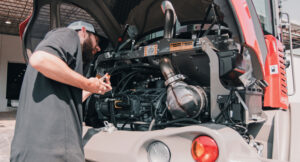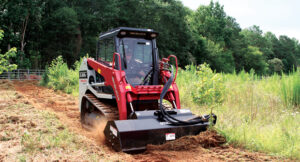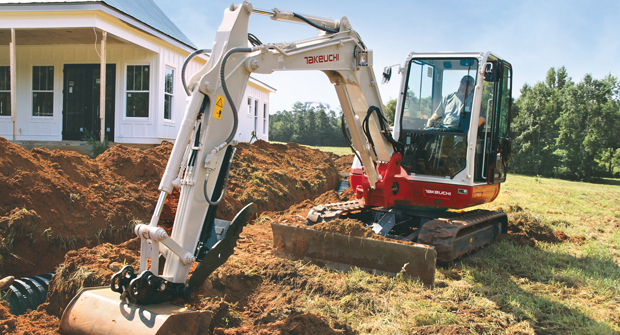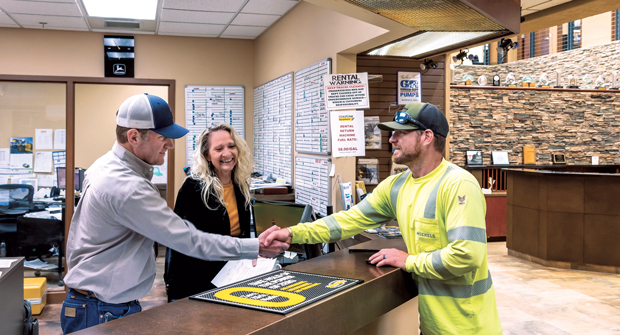Buying new machinery and landscaping equipment is no small task.
Between all the different kinds of loaders, mowers, tractors and more that can go into a fleet (not to mention the attachments, insurance, maintenance, etc.), investing in new equipment can be expensive to say the least.
It’s for that reason that choosing the right equipment in the right condition is crucial to best support company growth, and opportunities to save a pretty penny with pre-owned machinery become more enticing. Yet, like any used item passed down to its next owner, there’s always going to be concerns on its reliability, making it a riskier choice.
So, as the landscaping industry rides into another busy year, experts weighed in on some of the most important pros and cons to consider when looking at new vs. used equipment purchases and how to maximize the ROI on your investments.
Behind the price tag
The biggest and most obvious difference in new vs. used equipment is the upfront cost of the machine, with new options being significantly more expensive. However, if you have the budget, manufacturers have ways to make that big price tag become more manageable.
“New equipment typically requires a larger upfront investment, but manufacturers often provide competitive financing options, longer warranties and special incentives that can make purchasing new more accessible,” says Lee Padgett, national product manager at Takeuchi-US.
And if buying new is in the budget, landscape pros will be able to reap the benefits of having a fresh fleet in their arsenal.
“New equipment will usually be more reliable with minimal downtime, allowing contractors to focus on productivity rather than unexpected repairs,” Padgett says. “Telematics, fuel efficiency and hydraulics are state of the art on new machines compared with what you’ll find on older, used models. These are features that can improve job efficiency, reduce operating costs and potentially provide long-term value.”
However, there’s more than just that initial price tag to consider when making an equipment decision. Justin Noland, senior operations product manager at Kubota, says maintenance costs of used equipment can oftentimes surprise users if the machine isn’t reliable.
“You buy a used piece of equipment for $3,000. The next season, you’re spending $2,000 (on maintenance) that you weren’t necessarily anticipating or budgeting for,” Noland says. “How does that overall affect your business and what your plan is based on income?”
Plus, without the telematics and technological developments seen on new machines, used equipment can often struggle with lower job site and fuel efficiency, leading to higher costs over time. But that’s not to say that new equipment doesn’t also have its own issues with unexpected costs.

Insurance, financing, taxes and more are all expenses that can sometimes be overlooked amidst the excitement of purchasing a new maching, according to Padgett. If you’re not careful, interest rates and longer loans can quickly add up, making the price tag inflate more than initially expected.
“Insurance and financing costs can (sometimes) catch new owners off guard,” he says.
And if owners don’t have the right infrastructure to store and transport larger, newer machines, that can require further investments from users.
Turning ‘old’ into ‘old reliable’
Used equipment will always seem enticing with how much cheaper it is, but it’s important to remember that the drop in price is for a reason. Noland says as we enter the mowing and landscaping season this year, having mechanical failures sneak up on you could impact your productivity.
“With that cost savings, you trade the cost with the overall condition of the equipment,” Noland says. “You (often) don’t even know how somebody took care of that previously, so there’s some kind of unknowns as far as how well the maintenance was kept up.”
And if certain parts of an older machine have seen particular wear and tear — such as discharge shoots on lawn mowers — or if the machine is missing newer sensors and controls, safety can sometimes be an issue for operators or bystanders.
That’s why Noland recommends doing thorough research and going to a trusted dealer or shop technician for used equipment since they’re the ones with the expertise to conduct important inspections and ensure even used equipment is in proper operating condition.
“If you go off of Facebook Marketplace, and you’re looking at something there, then you’re relying a lot more on what the person selling the piece of equipment is telling you,” he says.
Buying used equipment from a trusted dealer is also important for future maintenance and serviceability. Noland says having some kind of local support network that can aid in providing parts, answering questions or making repairs can mitigate the inherent risks of used equipment, making them more viable.
“If you do ever encounter issues, you have that reliable partner to lean on, to help get your equipment back up and running,” Noland says. “That’s some of the things that you want to look out for.”
This kind of proactivity is exactly what Mike Giese, co-owner of Perfecturf Lawncare in Franksville, Wis., says will help make the best decision while reducing future

headaches with used equipment.
“I’d recommend getting detailed inspection reports, highlighting the equipment’s age and usage history, offering extended warranty options, emphasizing the importance of preventative maintenance and clearly communicating cost benefits associated with purchasing used equipment compared to new,” Giese says. “This allows customers to make informed decisions while mitigating potential issues with proactive maintenance strategies.”
New equipment, on the other hand, will always have an advantage thanks to the warranties that come with them, allowing for easier maintenance, machine/part replacements and more security in knowing the tool should have a longer lifespan.
Plus, Noland says some companies can even offer loaner programs such as Kubota’s Ever-Go. If a new machine needs to undergo a warranty-covered repair, Kubota will pick it up and give the user a comparable machine to borrow in the meantime, significantly reducing downtime.
Know your growth goals
Regardless of the differences between new and used equipment itself, one of the biggest factors to consider is how these options align with the goals of your company. The size of your operation, how often the machine will get used and how intense your jobs are all play a role in making this decision.
“If you’ll be using a machine daily for tough projects, a new model may be a better investment due to its durability and dependability. However, for less frequent use or specialized jobs, a well-maintained used machine could be more cost-effective and completely adequate,” says Takeuchi’s Padgett.
For Noland, he says reflecting on your long- and short-term goals as a company can help make the right decision and reduce the temptation to impulse buy. Even if a used piece of equipment appears at a great price, it still may be the wrong purchase if it doesn’t fit with your future plans for growth.
“Think more strategically, think more long term about what’s right for your business and what’s right for your overall budget and requirements and really understand what the pros and cons are,” Noland says.
And while knowing what your long-term goals are is important, Giese says knowing where your business stands in the present can also help ground yourself in realistic purchasing expectations. For smaller operations, the decision might be pretty straightforward.
“A landscaping company should lean toward buying used equipment when they are on a tight budget, need equipment for less intensive use or are a new business starting out,” Giese recommends. “Buying new equipment is better when they require high reliability, advanced features, a strong brand image or plan to use the equipment heavily and frequently, especially for large-scale projects.”
As Giese pointed out, an often overlooked feature of new equipment is how it helps boost your brand image. Having a new, high-tech and shiny piece of machinery can make you appear more professional and ready to tackle the job at hand. It’s not a great look if an older machine breaks down while working on-site.
Another factor to consider when thinking long term is how to maximize your return on the investment when choosing a machine, and Padgett says picking a machine that depreciates less in value could be a game-changer down the road.
“While all equipment depreciates, certain brands and models hold their value better than others. Choosing a machine with a strong reputation in the market can mean a higher return when it’s time to upgrade, offsetting some of the initial investment,” Padgett says.
Here to help
The choice between picking new or used equipment isn’t easy, and there are a lot of options, personal goals and what-ifs to consider. For the customer, it can sometimes be overwhelming or confusing.
That’s why on top of doing your own research, Giese says seeking help from dealers and other industry professionals is crucial, especially with ensuring the reliability of used equipment.
“To confidently buy used equipment, thoroughly research the equipment’s history, get a professional inspection from a trusted mechanic, test the equipment yourself, ask for maintenance records and consider buying from a reputable dealer with certified pre-owned options, ensuring you verify the seller’s reputation and check for any potential issues before making a purchase,” Giese recommends.
Regardless of what option you lean toward, Noland says approaching dealers is crucial in these decisions to gather all the facts. He says dealers are happy to help find the missing piece that best fits your business needs.
“Talking to a dealer that sells this equipment day in, day out — that understands the equipment from top to bottom — can give you a lot of good insights as to what truly are the benefits of buying a new piece of equipment,” Noland says. “Then, you have that knowledge and you have that information to make a better, informed decision.”


